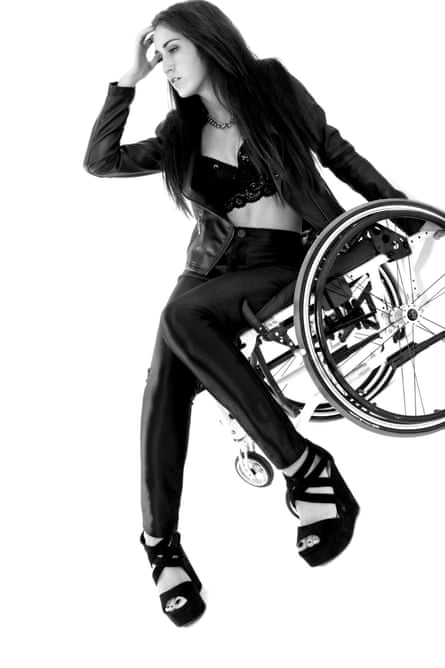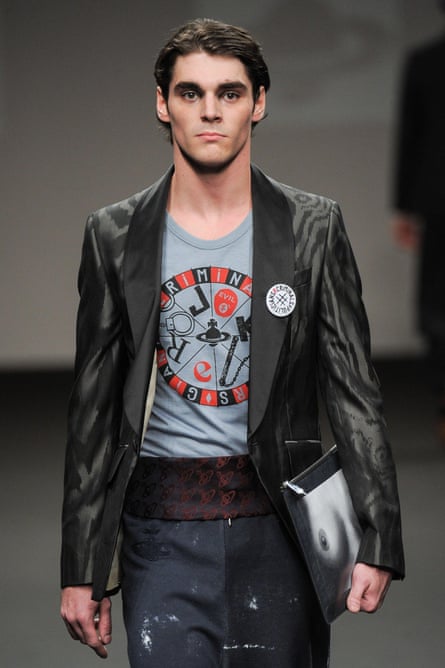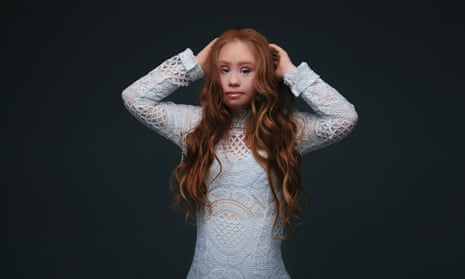Reading certain sections of the media over the past few weeks you might have thought that we were living in a golden age of diversity in fashion. Modelling – so the narrative goes – is finally opening its doors to people who reflect the eclectic beauty of the world’s population, with models with disabilities among those being welcomed to the fold.
This month Jillian Mercado, who has muscular dystrophy, was signed to IMG Models, the same agency as Gisele Bündchen. The American fashion blogger and editor has also featured in a Diesel campaign and has been photographed by the high priestess of fashion, Carine Roitfeld. Also this month, Madeline Stuart, an 18-year-old Australian who has Down’s syndrome, was announced as the face of cosmetics brand GlossiGirl and cast to walk at New York fashion week in September.
Mercado and Stuart are not the first models with disabilities to win headlines. In February the actress Jamie Brewer, who stars in the TV series American Horror Story, and who has Down’s syndrome, appeared on the catwalk for the US designer Carrie Hammer, while Armani collaborator Antonio Urzi’s designs were modelled by models with disabilities. In June the Breaking Bad actor RJ Mitte – who has cerebral palsy and has starred in a Gap campaign – walked for Vivienne Westwood.
This handful of examples is a drop in the ocean of a multibillion-pound global industry, but it does represent “some increase” in the use of models with disabilities, says Cat Smith, a doctoral researcher at London College of Fashion. “In general there is real cultural invisibility when it comes to disabled people – in fashion, on TV, in film, in politics, in writing,” she says. “So it’s certainly important to see disabled models, because seeing people who look like you is important in fostering empowerment and making you feel a little less invisible. Visibility also creates a more realistic representation and understanding of the lives of disabled people.
“But what I find frustrating,” she says, “is that you see the same thing over and over again. Fashion week comes around, a couple of shows include disabled models – and that is a good thing – but the coverage that follows is often quite patronising. It often becomes a fuzzy, inspirational human interest story, aimed at a non-disabled audience, rather than a step towards real inclusivity.”

The representation of models with disabilities is particularly paltry in the UK, according to Chelsey Jay, a campaigner and director of the models with a disability division at non-profit organisation Models of Diversity. Jay started using a wheelchair three years ago and argues that models should be representative of the population. (According to the latest government figures, 19% of the British population, more than 11 million people, have a disability.) “I’ve gone from seeing myself represented in fashion to being totally ignored, essentially because I am now sitting down, which is ridiculous.,” says Jay.
“I’ve always loved fashion – it can be so empowering,” she says. “But it also feels like that popular friend who is sometimes so nice to you and other times makes you feel like the worst person alive. It’s a big fat contradiction. [The industry] seems permanently on the cusp of change, but it never quite gets there.”
Often fashion’s arguments for not using models with disabilities are the same as those it cites for not using anyone over a size 10. Designers claim that models are not meant to reflect society but to be walking clothes-hangers – and clothes-hangers do not have breasts or wheelchairs.
Jay believes that argument is long out of date: “You can’t say that models are just mannequins. Things have moved on – models have an identity and a fan base through social media. One modelling agent told me that they are not trying to represent everybody, they are only trying to represent an elite group who buy that clothing, but disability is the one thing in the world that can affect absolutely anyone.”
Jack Eyers, a personal trainer and amputee who also works with Models of Diversity, has had great success as a fitness model (including featuring on the cover of Men’s Health) and more mixed experiences in fashion. He walked in the Antonio Urzi show at New York fashion week and loved it. “He made my leg part of the look, which I think is exactly the best way to go for people to accept [disability].” But in general, he says: “I think people look at the health and fitness side of things as inspirational, but in fashion it’s more of a one-off sob story – ticking a box. I don’t think, in fashion, people are viewing [models with disabilities] as attractive.”
Jay agrees that tokenism is rife. “Brands say, ‘we used a girl with Down’s syndrome three years ago’. But we are fighting for the same treatment, not special treatment.” She cites US catalogue Nordstrom as a rare exception, where models with disabilities are used every season, as a matter of course.

In designer fashion, there’s much praise for the 1998 collaboration between Alexander McQueen and athlete Aimee Mullins, who starred on the cover of Dazed & Confused’s famous “Fashion-able” issue and walked the McQueen catwalk wearing a pair of bespoke, intricately carved, wooden prosthetic legs. “I was in my teens when I saw that,” says Smith, “and when you are not used to seeing disabled people at all it was quite extraordinary. I thought – oh! disabled people can look really cool – it doesn’t have to be done in an ‘aren’t we being inclusive?’ way. It genuinely felt like McQueen took the artistic and creative possibilities around designing for bodies that look different rather than trying to fit people into little boxes.”
Nearly 20 years later, though, she says, “nothing has really developed beyond that in terms of mainstream or high fashion. You don’t get disabled models on the catwalk for McQueen these days – it tends to be smaller, less ‘out there’ designers, which I find interesting. There is a unique creative possibility there and I wonder why it’s not being addressed by artists who push boundaries in other ways.”
“If the high end did it, everyone would follow,” says Jay. “If you saw a Marc Jacobs or a Victoria’s Secret model with a disability – that would be so groundbreaking.”
Though the media tend to report disabled models’ catwalk appearances in a uniform way, there are vast differences in the projects different models have recently appeared in. RJ Mitte, for example, has operated at the top of the industry, via Gap and Vivienne Westwood; it helps that he had a huge pre-modelling following through his acting (“a lot of the time models who have disabilities still fall into the industry’s confines of ‘acceptability’ in other ways,” says Smith). Jillian Mercado is also working with some of fashion’s biggest names – including Diesel creative director Nicola Formichetti (who is famously Lady Gaga’s former stylist) and Roitfeld, the former editor of Vogue Paris.
Many other fashion shows that feature people with disabilities are special campaigning or charity shows with names like “Role Models not Runway Models” that feel a long way from the powerhouses of Chanel and Gucci. “There is a case for working outside the mainstream, but when it comes to visibility it’s all too easy to be ignored. Frustratingly, unless the mainstream pays attention, I don’t know how things are going to change,” says Smith.
Rosanne Stuart, mother of Madeline, has a different perspective. Her daughter expressed an interest in modelling after seeing a fashion parade at a fair in Brisbane, and caught the attention of a number of fashion brands after professional photographs she had taken and posted on Facebook went viral.
Rosanne says she was approached by three New York fashion week brands before choosing FTL Moda, because it is being run in collaboration with the Christopher and Dana Reeve Foundation. “We don’t do anything that isn’t to do with charity or that isn’t in line with our values,” she says. So Madeline is working with handbag brand EverMaya because it has agreed to donate 5% of sales to the Down’s Syndrome Association, with Manifesta because its clothing is specifically designed for a diverse range of body shapes, and for GlossiGirl, a vegan makeup company with the ethos: “if you ain’t a nice person, makeup won’t help”.
“Modelling means nothing to me,” says Rosanne. “What we are doing is not for money – we don’t usually get paid anyway – it’s an avenue to get the word out about inclusion and disability. I can see that working with big names might mean Madeline had broken boundaries, but I wouldn’t want to work with a big brand that didn’t have the right morals.”
In any case, perhaps the power that used to be in the hands of few has been transferred, a little bit, to the many. “We have had magazine offers that I have turned down, because I don’t like that magazine, and they say ‘but we have 25,000 readers,’ to which I think, ‘well, Madeline has 400,000 followers on Facebook.”
Those who do believe that models with disabilities need to break into the mainstream industry know that the challenges are huge. “It’s a vicious circle,” says Jay. “Modelling agencies say they don’t have disabled models on their books because brands won’t hire them; brands blame the modelling agencies, saying there are no models with disabilities there for them to hire. It’s impossible to point a finger at any one part of the industry.”
It would certainly help if there were more people with disabilities employed behind the scenes in creative positions – and more McQueen-like risk-takers. “It’s funny that fashion constantly talks about what’s new,” says Jay, “but the industry’s principles are painfully out of date.”

Comments (…)
Sign in or create your Guardian account to join the discussion